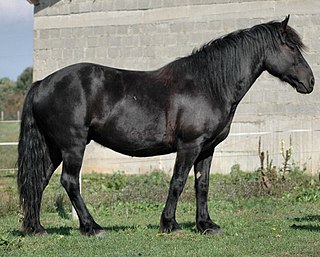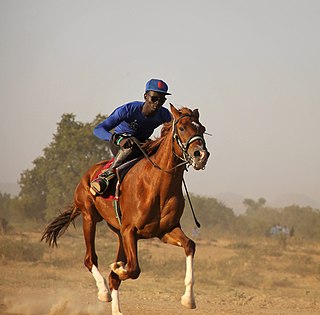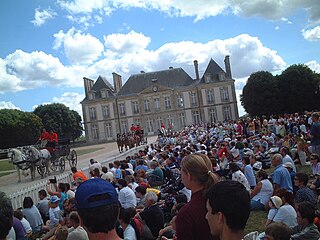
The Camargue, French: Camarguais or Cheval de Camargue, is a traditional French breed of working horse indigenous to the Camargue area in southern France. Its origins are unknown. For centuries, possibly thousands of years, these small horses have lived wild in the harsh environment of the Camargue marshes and wetlands of the Rhône delta, which covers part of the départements of Gard and Bouches-du-Rhône. There they developed the stamina, hardiness and agility for which they are known today. Traditionally, they live in semi-feral conditions in the marshy land of the region. The Camargue horse is the traditional mount of the gardians, the Camargue riders who herd the black Camargue bulls used for courses camarguaises in southern France.

The Novokirghiz or New Kirghiz is a modern Kyrgyz breed of horse. It was developed in the Kirghiz Soviet Socialist Republic in the mid-twentieth century through cross-breeding of the traditional Kyrgyz Horse of the region with introduced horses of Thoroughbred, Don and Anglo-Don stock.

The Mérens, Cheval de Mérens or Caballo de Merens, still occasionally referred to by the older name of Ariégeois pony, is a small, rustic horse native to the Pyrenees and Ariégeois mountains of southern France, where the river Ariège flows, and northern Spain, near Andorra. Two general types, a small, light traditional mountain horse and a taller, sportier modern type, are found. Always black in color, Mérens must meet strict physical standards in order to be registered in the stud book. The breed is known for its sure-footedness on mountain terrain, as well as for its endurance, hardiness and docility. The French breed registry organizes regional offices, and partners with other national organizations in Europe to preserve and promote the breed. The organization enforces rigorous selection of breeding stock, with a goal of increasing quality in the breed. In the past, the Mérens was used for farm work, draft work and as pack horses. Today it is mainly used as a saddle horse, although some members of the breed have been successful in carriage driving. Many Mérens are taken on an annual transhumance, in which they are moved higher in the mountains during the summer and into the valleys for the winter. An old practice, it fell into disfavor, but has recently re-emerged.

The Anglo-Norman horse is a warmblood horse breed developed in Lower Normandy in northern France. A major center of horse breeding, the area had numerous regional types that were bred to one another and then crossed with Thoroughbreds to form the Anglo-Norman. Various body types developed within the Anglo-Norman breed, two of which were split off to form the Norman Cob and French Trotter. The remaining types were eventually standardized, although there remained some criticism of the "hybrid" nature of the breed's conformation. However, it is successful as an international sport horse, especially in the sport of show jumping. The Anglo-Norman also contributed to the development of several other breeds in Europe and Asia.

The Charolais or Charollais is an extinct breed of warmblood horse from the Charolais, the country lying around the town of Charolles, now in the Saône-et-Loire département of Burgundy, in eastern central France. Like other French warmbloods, it was the result of crossing local agricultural horses with the Thoroughbred, and was known by the name of the region without ever having a specific stud-book. Like other French warmbloods including the Angevin, the Charentais, the Cheval Limousin and the Vendéen, it was fused with the Anglo-Normand in 1958 in order to create the national warmblood stud-book, the Selle français. It was originally used as a multi-purpose horse for riding, driving, and agriculture. During the late 19th century, additional Thoroughbred blood was added and a new type emerged that was principally used as a light cavalry mount. It was also used for dressage and show jumping.

The Norman Cob or Cob Normand is a breed of light draught horse that originated in the region of Normandy in northern France. It is of medium size, with a range of heights and weights, due to selective breeding for a wide range of uses. Its conformation is similar to a robust Thoroughbred, and it more closely resembles a Thoroughbred cross than other French draught breeds. The breed is known for its lively, long-striding trot. Common colours include chestnut, bay and seal brown. There are three general subsets within the breed: horses used under saddle, those used in harness, and those destined for meat production. It is popular for recreational and competitive driving, representing France internationally in the latter, and is also used for several riding disciplines.

Marine Oussedik, is a painter, sculptor and an illustrator specialized in horses. In 1990, she graduated from ESAG Penninghen, the Higher College of Graphic Arts, and started exhibiting in Parisian galleries the following year. Immediately afterwards she was commissioned paintings by the Living Museum of the Horse in Chantilly to be permanently displayed in two rooms. At the same time she published a book, Les chevaux d'encre. Many art books would follow including Les chevaux du Sahara in 1998, Les chevaux du vent in 2002 and Les chevaux de rois in 2003. She would be rewarded by Prix Pégase for those last two books which testify to her passion for illustrations of all kind of horses, Arabians being her favorite. In 2014, she illustrated an art book dedicated to classical French riding with texts by Guillaume Henry.

Pierre-Nicolas Tourgueneff was a French animalier sculptor and painter who worked in the late 19th century and early 20th century. He was a cousin of the writer Ivan Sergeyevich Turgenev. He began to exhibit his sculptures at the Salon in 1880 and continued to do so throughout his career.
Laurence Bougault was a French writer and academic. She was also well known as a long-distance adventurer on horseback.

The minor presence of horses in Togo comes out of a few breedings and practices of equestrianism represented, at the end of the 19th century and at the beginning of the 20th century, in the region of Mango and in the north of the current country. Horses were introduced at that time thanks to the Tem, who were the founders of a small kingdom that focused on the use of rifles and cavalry. The distribution of horses in the south is much more recent, as breeding was very limited due to the presence of the tsetse fly. After sporadic imports of horses by German and French colonial troops, a diplomatic gift from Niger in the 1980s allowed the creation of the first Togolese honorary cavalry regiment. The use of the horse-drawn vehicle has always been unknown in Togo.
Kheir is a gray Barb horse, born in 2004 at the National Stud of Chaouchaoua in Algeria, and then given as a diplomatic gift to the French President Nicolas Sarkozy in 2007. He was subsequently sent to the National Stud of Les Bréviaires in France and trained for equestrian shows.

Haguard horse, also known as the Hague pony or bidet de la Hague, is a breed of bidet horse native to the natural region of La Hague, in the Manche in Normandy.

The history of horses in Cameroon is linked above all to the traditional presence of this animal in the northern regions of the country, around Lake Chad from the 16th century, then in Adamawa, as well as in the Garoua and Maroua regions. Traditional equestrian practices in Cameroon, such as horse parades and horse dances, have more recently been joined by equestrian activities, under the influence of Western expatriates and investors, notably in Yaoundé since the 1990s. The main use of horses in Cameroon is in agriculture and transport fields.

In Kyrgyzstan, as in all countries with a Turko-Mongol nomadic culture, horses are an important part of the local economy and identity. Originally a status symbol, the possession of numerous horses enables Kyrgyz nomads to carry out military operations, hunt and move around their mountainous country. Ownership of large herds was banned during the Soviet era, causing many difficulties for the Kyrgyz. The Russians tried to replace the traditional breed with a crossbred horse, the NovoKyrgyz, but the local horse has survived to the present day. After a period of crisis in the 1990s, horse breeding and the consumption of mare milk are enjoying a revival, as are traditional equestrian games and festivals.

In China, horses are present both physically and in art and beliefs, particularly those relating to astrology. In 1985, China had the world's largest herd of horses, numbering 11 million. China was at the origin of post houses in Eurasia. Since the 2000s sport and leisure riding have been developing in China, mainly for wealthy people.

Horses in Normandy have a clear economic importance, particularly through breeding. Present since the Bronze Age, horse breeding developed with the establishment of the Haras du Pin stud farm. Horses are still a very much alive tradition in this region. Normandy boasts a number of renowned racecourses, in particular the one in Deauville, where events take place regularly, including international ones such as the 2014 World Equestrian Games.

Absinthe is a black stallion of the Akhal-Teke breed, born in 1952 in Kazakhstan under the Union of Soviet Socialist Republics. Spotted by Marshal Semyon Budyonny, this son of the stallion Arab obtained the first world record for the number of Olympic titles in the dressage discipline, with Soviet horseriders Sergei Filatov and Yvan Kalita.

The Amourski, also known as Amur horse or Manchurian pony, is an extinct breed of small Siberian and Manchurian horses. Formed in the early 19th century, it originated from the area around the Amur River in northeast Asia, in Russia and China. These small horses, more refined than other Siberian breeds, were usually ridden or driven, and were known for their hardiness.

A meat horse, or slaughter horse, is a horse bred for its ability to yield meat. Coming from draft horses formerly used for agricultural work, these horses are threatened with extinction by the mechanization of agricultural activities. This state of affairs has prompted breeders to look for new economic outlets. Breeding for meat horses was very popular in France in the 1980s, helping to safeguard these breeds. It has developed in Italy and Spain, but is declining in France, due to the further reduction of work activities with draft horses.

The Orlov-Rostopchin, or Russian saddle horse, is a breed of saddle and sport horse originating in Russia. Born in the 19th century from the fusion of the breeding saddle horses of Counts Orlov and Rostopchin, it has had an eventful history. Very famous at the end of the 19th century as a dressage and cavalry horse, the breed was decimated after the First World War. It was restored by Semion Boudienny, and became known as the "Russian Saddle". Virtually extinct after the Second World War, it was unofficially recreated in the 1950s to produce the Ukrainian Saddle. Thanks to its success in dressage competitions up to international level, Russian breeders have been officially reviving it since 1978, from crosses with Trakehners. The Russian saddle still suffers from a lack of recognition.























